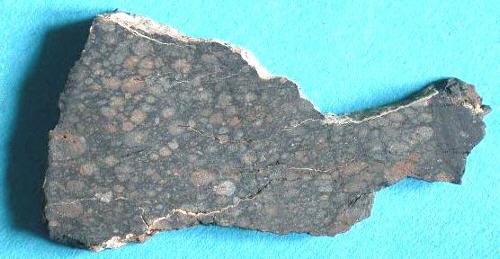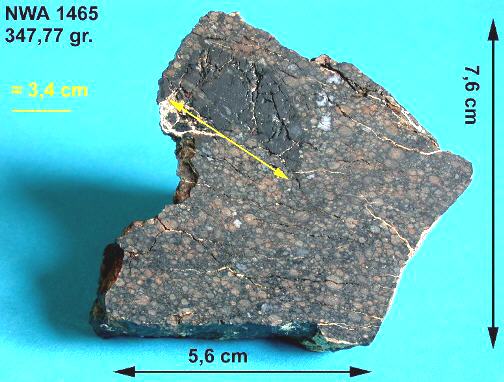CV3-anomalous

Found 2001
no coordinates recorded Many fusion-crusted fragments weighing together 3 kg were found in the Western Sahara desert, and were subsequently acquired by a German meteoriteWork in progress. A solid natural object reaching a planet’s surface from interplanetary space. Solid portion of a meteoroid that survives its fall to Earth, or some other body. Meteorites are classified as stony meteorites, iron meteorites, and stony-iron meteorites. These groups are further divided according to their mineralogy and Click on Term to Read More collector in 2002. Analysis and classification was conducted at the Museum für Naturkunde, Institut für Mineralogie, Humboldt-Universität zu Berlin, Germany (Greshake et al., 34th LPSC, #1560 [2003]). The name NWA 1465 was assigned to this meteorite by the Nomenclature Committee of the Meteoritical Society.
This
carbonaceous chondriteCarbonaceous chondrites represent the most primitive rock samples of our solar system. This rare (less than 5% of all meteorite falls) class of meteorites are a time capsule from the earliest days in the formation of our solar system. They are divided into the following compositional groups that, other than Click on Term to Read More has a bulk mineralogy and composition similar to the CV3
chondritesChondrites are the most common meteorites accounting for ~84% of falls. Chondrites are comprised mostly of Fe- and Mg-bearing silicate minerals (found in both chondrules and fine grained matrix), reduced Fe/Ni metal (found in various states like large blebs, small grains and/or even chondrule rims), and various refractory inclusions (such Click on Term to Read More, but with O-isotopes that plot nearest to the CR trend line (Greshake
et al., 2003).
ChondrulesRoughly spherical aggregate of coarse crystals formed from the rapid cooling and solidification of a melt at ~1400 ° C. Large numbers of chondrules are found in all chondrites except for the CI group of carbonaceous chondrites. Chondrules are typically 0.5-2 mm in diameter and are usually composed of olivine Click on Term to Read More measuring up to several mm in size are strongly foliated like those in the Leoville CV3 carbonaceous
chondriteChondrites are the most common meteorites accounting for ~84% of falls. Chondrites are comprised mostly of Fe- and Mg-bearing silicate minerals (found in both chondrules and fine grained matrix), reduced Fe/Ni metal (found in various states like large blebs, small grains and/or even chondrule rims), and various refractory inclusions (such Click on Term to Read More. Also exhibiting foliation are an abundance of tens of µm- to cm-sized, melilite-rich
CAISub-millimeter to centimeter-sized amorphous objects found typically in carbonaceous chondrites and ranging in color from white to greyish white and even light pink. CAIs have occasionally been found in ordinary chondrites, such as the L3.00 chondrite, NWA 8276 (Sara Russell, 2016). CAIs are also known as refractory inclusions since they Click on Term to Read More fragments, probably derived from compact Type A
CAIsSub-millimeter to centimeter-sized amorphous objects found typically in carbonaceous chondrites and ranging in color from white to greyish white and even light pink. CAIs have occasionally been found in ordinary chondrites, such as the L3.00 chondrite, NWA 8276 (Sara Russell, 2016). CAIs are also known as refractory inclusions since they Click on Term to Read More (Simon
et al. 70th MetSoc,
#5071 [2007]). Many refractory assemblages have been identified in NWA 1465. Some of the CAI fragments are hibonite-bearing, while others contain fassaite assemblages having the highest TiO and lowest MgO contents known among CAIs. The unexpected finding of silica-rich glass in contact with
meliliteGroup of minerals found in the CAIs of meteorites such as CV chondrites. Melilite consists almost exclusively of the binary solid solution gehlenite (Ca2Al2SiO7) – åkermanite (Ca2MgSi2O7). The melilite in CAIs is closer to gehlenite in composition. The first-formed (highest-temperature) melilite crystallizing from a melt is relatively aluminum-rich and becomes progressively Click on Term to Read More is poorly understood.
The fine-grained
matrixFine grained primary and silicate-rich material in chondrites that surrounds chondrules, refractory inclusions (like CAIs), breccia clasts and other constituents. Click on Term to Read More material is composed primarily of Fe-rich
olivineGroup of silicate minerals, (Mg,Fe)2SiO4, with the compositional endpoints of forsterite (Mg2SiO4) and fayalite (Fe2SiO4). Olivine is commonly found in all chondrites within both the matrix and chondrules, achondrites including most primitive achondrites and some evolved achondrites, in pallasites as large yellow-green crystals (brown when terrestrialized), in the silicate portion Click on Term to Read More, along with Ca-rich
pyroxeneA class of silicate (SiO3) minerals that form a solid solution between iron and magnesium and can contain up to 50% calcium. Pyroxenes are important rock forming minerals and critical to understanding igneous processes. For more detailed information, please read the Pyroxene Group article found in the Meteoritics & Classification category. Click on Term to Read More,
enstatiteA mineral that is composed of Mg-rich pyroxene, MgSiO3. It is the magnesium endmember of the pyroxene silicate mineral series - enstatite (MgSiO3) to ferrosilite (FeSiO3). Click on Term to Read More,
forsteritePure* magnesium end-member (Mg2SiO4) of the olivine solid solution series and an important mineral in meteorites. When magnesium (Mg) is completely substituted by iron, it yields the the pure Fe-olivine end member, fayalite (Fe2SiO4). The various Fe and Mg substitutions between these two end-members are described based on their forsteritic (Fo) Click on Term to Read More,
troiliteBrass colored non-magnetic mineral of iron sulfide, FeS, found in a variety of meteorites. Click on Term to Read More,
magnetiteFe oxide, Fe2+Fe3+2O4, containing oxidized iron (Fe3+) found in the matrix of carbonaceous chondrites and as diagnostic component in CK chondrites. In CK chondrites, magnetite is typically chromian, containing several wt. % Cr2O3. Click on Term to Read More, and FeNi-metal. A variety of shock features are present in olivines, and melt veins and melt pockets occur within chondrules and matrix, features that are consistent with
shock stageA petrographic assessment, using features observed in minerals grains, of the degree to which a meteorite has undergone shock metamorphism. The highest stage observed in 25% of the indicator grains is used to determine the stage. Also called "shock level". Click on Term to Read More S4. Terrestrial weathering has progressed to grade W3.
Within the host meteorite are large (>3 cm) dark inclusions that have O-isotope ratios similar to matrix material found in Al Rais (anomalous, CR clan), and close to those of dark inclusions found in Belgica 7904 (petrographically and chemically CM-like, but isotopically CI-like), as well as in Leoville and Vigarano (both CV3-reduced). These dark inclusions have O-isotope ratios and chemical compositions that deviate significantly from the host meteorite and from typical CI/CM-like dark inclusions commonly present in CV3 chondrites. Furthermore, in contrast to the visually distinct boundaries of typical CV3 dark inclusions, the dark inclusions in NWA 1465 exhibit an imperceptible contact with the host meteorite, resolvable only through high magnification. These dark inclusions also exhibit none of the shock effects that are prevalent in the host meteorite, which suggests that they accreted after this shock event occurred. Chondrule-free dark inclusions like the one embedded in NWA 1465 might represent the primitive precursor material of magmatic CC irons, which accreted before the onset of
chondruleRoughly spherical aggregate of coarse crystals formed from the rapid cooling and solidification of a melt at ~1400 ° C. Large numbers of chondrules are found in all chondrites except for the CI group of carbonaceous chondrites. Chondrules are typically 0.5-2 mm in diameter and are usually composed of olivine Click on Term to Read More formation in the region of the
protoplanetary diskFlattened and rotating disk of dense gas and dust/solids orbiting a young star from which planets can eventually form. Click on Term to Read More beyond Jupiter (A. Rubin, 2018).
Other CV3 meteorites have been either officially designated as anomalous members or argue for such a classification based on independent research; examples include ALHA81003, Camel Donga 040, MET 01017, and NWA 1152. Notably, NWA 1465 is chemically
reducedOxidation and reduction together are called redox (reduction and oxidation) and generally characterized by the transfer of electrons between chemical species, like molecules, atoms or ions, where one species undergoes oxidation, a loss of electrons, while another species undergoes reduction, a gain of electrons. This transfer of electrons between reactants Click on Term to Read More. The specimen of NWA 1465 shown above is a 5.1 g partial slice that contains a small portion of a dark
inclusionFragment of foreign (xeno-) material enclosed within the primary matrix of a rock or meteorite. Click on Term to Read More on the right edge. The photo below shows a full slice that has been sectioned through one of these unusual inclusions.

Photo courtesy of S. Kambach








